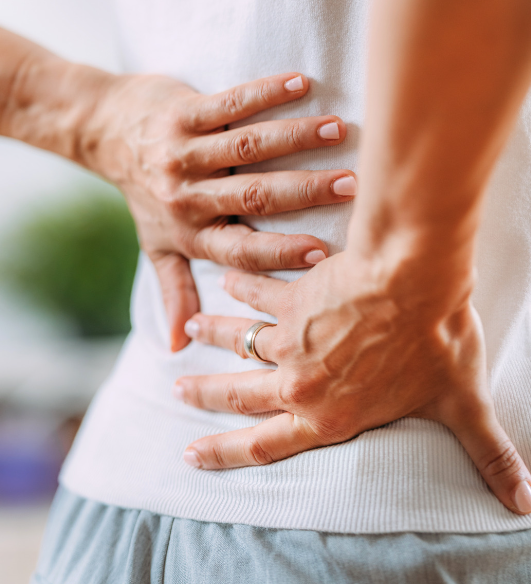Lower back pain is one of the most common complaints we hear from patients at our Mt. Hope Chiropractic offices. In fact, studies suggest that up to 80% of Americans will experience back pain at some point in their lives. Many of us endure long commutes, shovel heavy snow in winter, or work in industries requiring physical labor or prolonged sitting, making back pain particularly prevalent.
The good news? Many cases of lower back pain can be prevented or managed effectively with the right proactive approach.
Why We’re Vulnerable to Lower Back Pain
Our modern lifestyle creates unique challenges for back health. Consider these factors:
- Seasonal activities: From snow shoveling in winter to garden work in spring, seasonal activities put specific demands on our spines
- Commuting patterns: Long commutes and extended periods of sitting can strain your lower back
- Workplace demands: Our diverse economy means many of us work in settings that challenge our backs, from healthcare professionals to manufacturing employees
- Recreational activities: Physical hobbies and weekend activities can sometimes lead to overexertion
Understanding these factors helps us develop targeted prevention strategies.
The Three Types of Back Problems
At Mt. Hope Chiropractic, we approach back pain by considering which of these three issues might be present:
1. Mechanical Problems
When the spine loses its optimal range of motion, pain often follows. This can result from:
- Joint restrictions
- Muscle imbalances
- Poor movement patterns
- Previous injuries
2. Functional Problems
These occur when different parts of your body aren’t coordinating properly. For example, if your hip and core muscles don’t communicate effectively during walking, your lower back may compensate, leading to pain over time.
3. Strength Problems
Sometimes, your muscles simply aren’t strong enough for the demands placed on them. This is particularly common among:
- Desk workers with weakened core muscles
- Healthcare workers who need to lift patients
- Warehouse employees moving heavy items
- Parents constantly lifting children
Identifying which of these issues is contributing to your back pain allows for more effective prevention and treatment strategies.
Proactive Daily Exercises for Lower Back Health
Based on our experience treating patients throughout Monroe County, we’ve identified several key exercises that can help Rochester residents maintain lower back health. Just 5-10 minutes daily can make a significant difference:
1. Pelvic Tilts (10 reps)
This gentle exercise helps restore proper movement to your lower spine and activates your core:
- Lie on your back with knees bent and feet flat
- Notice the natural arch in your lower back
- Gently flatten your lower back against the floor by tightening your abdominal muscles and slightly tilting your pelvis
- Hold for 2-3 seconds, then release back to the starting position
- Repeat 10 times
Many of our Penfield patients with desk jobs find this exercise particularly helpful for relieving tension after a long workday.
2. Lower Back Press-Up (5 reps)
This movement helps decompress the lower spine and is especially beneficial for those experiencing stiffness:
- Lie face down with your hands positioned near your shoulders, as if you’re going to do a push-up
- Keeping your hips on the floor, gently press your upper body up
- Only lift as far as is comfortable—this isn’t about reaching maximum height
- Hold for 1-2 seconds at the top, then lower slowly
- Repeat 5 times
This exercise is particularly helpful for Rochester residents who spend long hours sitting during our cold winter months.
3. Hip Hinge Practice (5 reps)
Learning proper hip hinging is fundamental for back health and injury prevention:
- Stand with your feet shoulder-width apart
- Place your hands on your hips
- Keep your back flat while bending forward from your hips (not your waist)
- Feel the movement in your hip joints rather than your spine
- Only go as far as comfortable while maintaining a flat back
- Return to standing by engaging your gluteal muscles
- Repeat 5 times
Mastering this movement can help prevent injuries during everyday activities like gardening, snow shoveling, or picking up items from the floor—all common tasks for homeowners in the Rochester area.
4. Cat-Cow Stretch (5-10 reps)
This gentle movement improves spinal mobility:
- Begin on your hands and knees
- Inhale as you drop your belly and lift your head (cow position)
- Exhale as you round your back and tuck your chin (cat position)
- Move slowly between these positions 5-10 times
- Focus on feeling the movement throughout your entire spine
5. Bird Dog (5 reps each side)
This exercise builds core stability and coordination:
- Start on hands and knees
- Simultaneously extend your right arm forward and left leg backward
- Keep your back flat and core engaged
- Hold for 2-3 seconds
- Return to the starting position
- Repeat with the opposite arm and leg
- Complete 5 repetitions on each side
This exercise is especially beneficial for improving the functional strength needed for activities like hiking and yard work.
Beyond Exercise: Comprehensive Strategies for Back Health
While targeted exercises are essential, a comprehensive approach to back health includes several other factors:
Ergonomic Considerations for Remote Workers
With many companies now offering remote work options, home office setups have become increasingly important. Ensure your workspace supports proper posture with:
- A chair that supports your lower back
- A desk at the appropriate height
- Regular movement breaks (set a timer to stand up every 30 minutes)
Proper Lifting Techniques
Whether you’re shoveling snow or carrying groceries, proper lifting technique is crucial:
- Keep the object close to your body
- Bend at the knees, not the waist
- Avoid twisting while lifting
- Ask for help with heavy items
Stress Management for Back Health
The mind-body connection is powerful. Stress can cause physical tension in the muscles supporting your spine. Consider:
- Taking regular walks in nature
- Practicing mindfulness or meditation
- Using breathing exercises during stressful moments
- Enjoying cultural activities as mental breaks
Sleep Optimization
Your sleep position and mattress quality significantly impact back health. Consider:
- Sleeping on your side with a pillow between your knees
- Ensuring your mattress provides adequate support
- Using a small pillow under your lower back if you sleep on your back
- Replacing older mattresses that have lost their support
When to Seek Professional Care
While these proactive measures can significantly reduce your risk of lower back pain, sometimes professional intervention is necessary. Consider scheduling an appointment at Mt. Hope Chiropractic if:
- Pain persists despite your best efforts
- You experience numbness or tingling in your legs
- Pain is severe or wakes you from sleep
- You’ve recently experienced an injury
- Your pain limits your daily activities
- You’re unsure which exercises are appropriate for your specific condition
Our approach at Mt. Hope Chiropractic combines evidence-based treatments with personalized care. We don’t just treat symptoms—we identify and address the root causes of your discomfort.
The Mt. Hope Chiropractic Difference
At our Penfield and Brighton locations, we take a comprehensive approach to lower back health that includes:
- Thorough assessment to identify mechanical, functional, or strength issues
- Personalized treatment plans tailored to your specific needs
- Education on preventative strategies relevant to your lifestyle
- Hands-on care to restore proper function
- Guidance on appropriate exercises and activities
Our goal isn’t just to relieve your current pain but to empower you with tools and knowledge to prevent future issues.
Take Action for Your Back Health Today
Don’t wait until back pain interferes with your ability to enjoy your favorite activities. Take a proactive approach to your back health today.
Start by incorporating these simple exercises into your daily routine. Just 5-10 minutes can make a significant difference in how you feel and function.
For personalized guidance and care, schedule an appointment at our Penfield or Rochester office. Our experienced team is ready to help you move better, feel better, and live better.
Book your appointment today. Your back will thank you!











